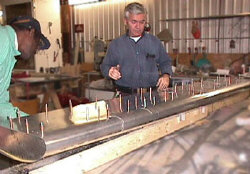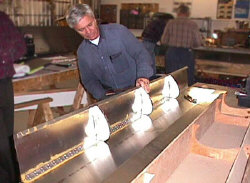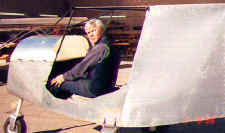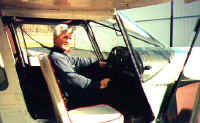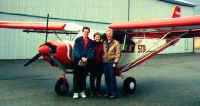
Giving Wings to the Word...
|
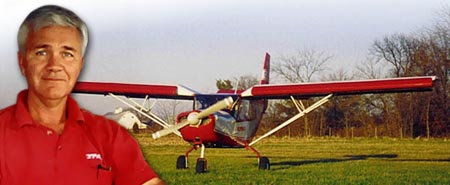
What a wonderful time to be busy in His exciting service! Today's missionaries travel by mule, canoe or on foot into the most remote areas of the world discovering peoples from the stone age who have never had the opportunity to hear the name of Christ. By the light of a camp fire, in front of a tent or hut and in a setting not unlike that of Livingstone's time, they pull out a notebook and record the days’ information.
Then, instead of tucking the "notebook" into a back pack, they plug in a modem, and along with the portable satellite link, transmit the data to the home base along with their GPS location. Today's Livingstone doesn't need days, weeks or even months to exchange information. With the wise use of technology, it takes seconds to upload or download information to and from almost any place on the planet. To Livingstone, "downloading" probably meant removing the burden from a porter's head.
In the time it took some missionaries of 50 years ago to arrive at their place of ministry, we can have a mission station set up; the beginning of a dictionary in a new language and possibly new believers added to God's kingdom. We are eager to use the most effective equipment possible to speed the Good News to those in need. One might say that it is irresponsible to use older, less effective technology if the newer, more effective is accessible and affordable.
Surprisingly, aviation -- one of the main tools that has changed the effectiveness of missions in our generation -- is trailing far behind most other areas of technology. Who would advocate sending a brand new fleet of vehicles to our missionaries that was designed in the "forties" and early "fifties"? -- especially if they were priced far above today's price for newly designed vehicles! Would it help if the builders called them "state-of-the-art"?
That is precisely what is happening in general aviation. The aircraft engines we use today are basically unchanged from those built in the late "thirties". With relatively small changes, the airframes come from the early "fifties". Automobile and even farm equipment technology has advanced far beyond that of general aviation. There have been minor improvements in instrumentation and neat advances in navigation and communication equipment. But the "bird" is basically ancient.
Wouldn't it be great if a medical missionary, a pastor, engineer, teacher or evangelist could fly around his or her field of ministry from airstrips of 200 to 300 feet in a safe, economical, all metal aircraft? And wouldn't it be wonderful if that aircraft burned auto gas (a lot more accessible on the mission field than avgas) and could be maintained by any competent auto mechanic? What if the total cost of operation was less than the cost of running the average missionary land vehicle? What if the pilot could fly it safely with much less time and money invested? Perhaps it deserves a place in today's mission world!!
THE DESIGNER
Chris Heintz, one of the design engineers on the famous Concorde supersonic jetliner and a stress analyst for de Havilland aircraft for some years is well known in Canada and around the world. For the last 25 years, as the founder and owner of Zenair Ltd., Chris has been producing light recreational aircraft. In 1994, he received type certification in Canada and the USA for his Zenith CH 2000 design. This was the first general aviation aircraft to be certified in Canada in the last 30 years.
THE AIRCRAFT
The three Heintz aircraft designs that would prove a real blessing to today's Livingstones are:
- The Zodiac CH 601. This plane can fly between 110 and 140 MPH on 13 to 16 liters of fuel per hour and operate out of fields of 400 to 500 feet in length with two people on board and lots of baggage. It is a sporty looking machine but still quite capable on rough fields.
- The STOL CH 701. The 701 is also a two place aircraft that can take-off, fully loaded, in just 100 feet. It can also carry most of the equipment a missionary needs for his or her work. While it cruises at 70-85 MPH, it can go into areas where no other all metal, fixed-wing airplane can. It is already being used by missions and Third World customers around the world.
- The new STOL CH 801. This aircraft has been designed to go into very short fields (260 feet for take-off at gross weight) and carry a useful load of 1,000 pounds. With four seats and a cruise speed of about 115 MPH. The 801 has been developed specifically for work in third world countries. More about this one later.
There is an effective, safe, affordable alternative! That is what I would like to present to you now.
My own background::
| 1966-1970 | Youth Pastor in Vancouver, Canada. |
| 1972-1976 | Bible School Teacher in Zaire with Africa Inland Mission |
| 1976-1980 | Flight & Aircraft Maintenance training, Northrop Institute of
Technology, Los Angeles, CA. Missionary/pilot with The Shantymen's Christian Association in western Canada. Teacher at Trinity Western University, Department of Aviation |
| 1980-1987 | Pilot/mechanic with Mission Aviation Fellowship in Bukavu, Zaire. |
| 1987-1990 | Operations Manager with MAF in Dodoma, Tanzania. |
| 1990-1994 | Overseas Staff Facilitator (Pastor to overseas staff) with MAF Canada. |
| 1994-Pres. | Owner of Flypass Ltd at the Waterloo Regional Airport, in Kitchener, Ontario, Canada (flight training, aircraft assemblies and sales). |
Over the past several years, at home and abroad, I have experienced some of the blessings and problems that are part of missionary aviation.
In the past, most missions wisely demanded that the pilot be dedicated to the aviation task alone. That was important, given the complexity of the aircraft available and the difficulty of navigating in the third world. That also required pilots who were trained as aircraft mechanics. Preparation time for a missionary pilot normally took from three to five years and more. For the traditional and necessary work of the full-time pilot, that is still true.
Please understand that the need for professional missionary pilots is as great as ever. However, recent changes in aviation technology have opened the door to much greater use of aircraft by the "non-professional". On our highways we have professional drivers who are highly trained and dedicated to the job of driving. On those same roads there are people who safely use vehicles to go from place to place for work and pleasure. The average pastor does not spend the day on the road at the controls of an eighteen wheeler. Neither does he call for a professional driver every time he needs to go visiting someone in need.
Are these toys or real aircraft?
I believe that each of these airplanes are superior to our older, traditional machines
just as today's automobiles are superior to those of 30 years ago. More than that, they
are easier and safer to fly. The operating cost is less than one half of the older planes
and maintenance is also much simpler.
Can they be used safely on the mission field?
These aircraft are much easier to fly safely, with less training than required by the
aircraft currently being used in missionary service. They might not be useful on every
overseas program but they will be very helpful in many of our fields.
The STOL CH 801
Over the last two years I have been building a new type of aircraft specifically for work in the Third World. The Heintz design is based on a proven light aircraft, the STOL CH 701. The 701 is a light, all metal, two place airplane that takes off normally in 30 meters (100 ft). My objective in developing the new plane was to be able to take off with four full-size adults and full fuel (approx.1,000 lbs) in the length of a football field.
We’ve recently completed the first STOL CH 801 for missionary service. It is going into service among the Yanomamo people in the jungle of Venezuela. The program has the approval of the mission and blessing of MAF locally.
Throughout the development of this aircraft God has provided us with protection, provision and some very special guidance. Chris Heintz provided all the engineering and encouragement. All the work was done under his watchful eye and guidance. Dr. Owen Maynard has been a very special mentor and encourager throughout the program. Dr. Maynard was the Chief Of Project Engineering for the Apollo Space Program from conception through Apollo 12. He was also one of the designers for AVRO, working on the CF 100, the Jetliner and the Arrow. He is an enthusiastic supporter of the STOL CH 801.
The STOL CH 801 is not meant to replace the aircraft currently working with MAF and other dedicated mission aviation programs. Rather it is designed to allow missionaries and nationals to expand their work to places that the other aircraft may not be able to get into. It is also meant to radically reduce the cost of transportation in the ministry without reducing safety. The wise use of modern technology and proven engineering has produced an airplane that almost anyone can operate safely with proper training.
It has been said that everything in aviation is a compromise. There is no aircraft that can go 500 miles per hour, land on a football field, carry several tons and cost less that $1,000,000. The STOL CH 801 was not designed to compete with any other airplane. It will not travel as fast as some mission aircraft. It will not carry quite as much. It is not as "pretty". Those factors were not considered as most important in its development.
However, while we may have compromised in those things we have not compromised in safety, utility, simplicity or stewardship of resources. One successful businessman who has considerable holdings in aviation has told me that the STOL CH 801 will change aviation, as we know it, in the Third World.
If you would like to learn more about the STOL CH 801 or any of the other kit planes, or Flypass Ltd., please contact me at your convenience. I would be delighted to meet with you to share more or answer questions that this article may have raised. Thank you for your time and may God bless you to be a blessing to many in the time we have remaining.
Art Mitchell,
former President,
Flypass Ltd.
[Back]
NOTE: This article represents the viewpoints of the author, and not necessarily those of Zenith Aircraft Company.
|
ZODIAC Series |
© Zenith Aircraft Company
2013-09-30
Zenith.Aero: Online community for active Zenith builders, owners and pilots Zenith Aircraft
Company |
